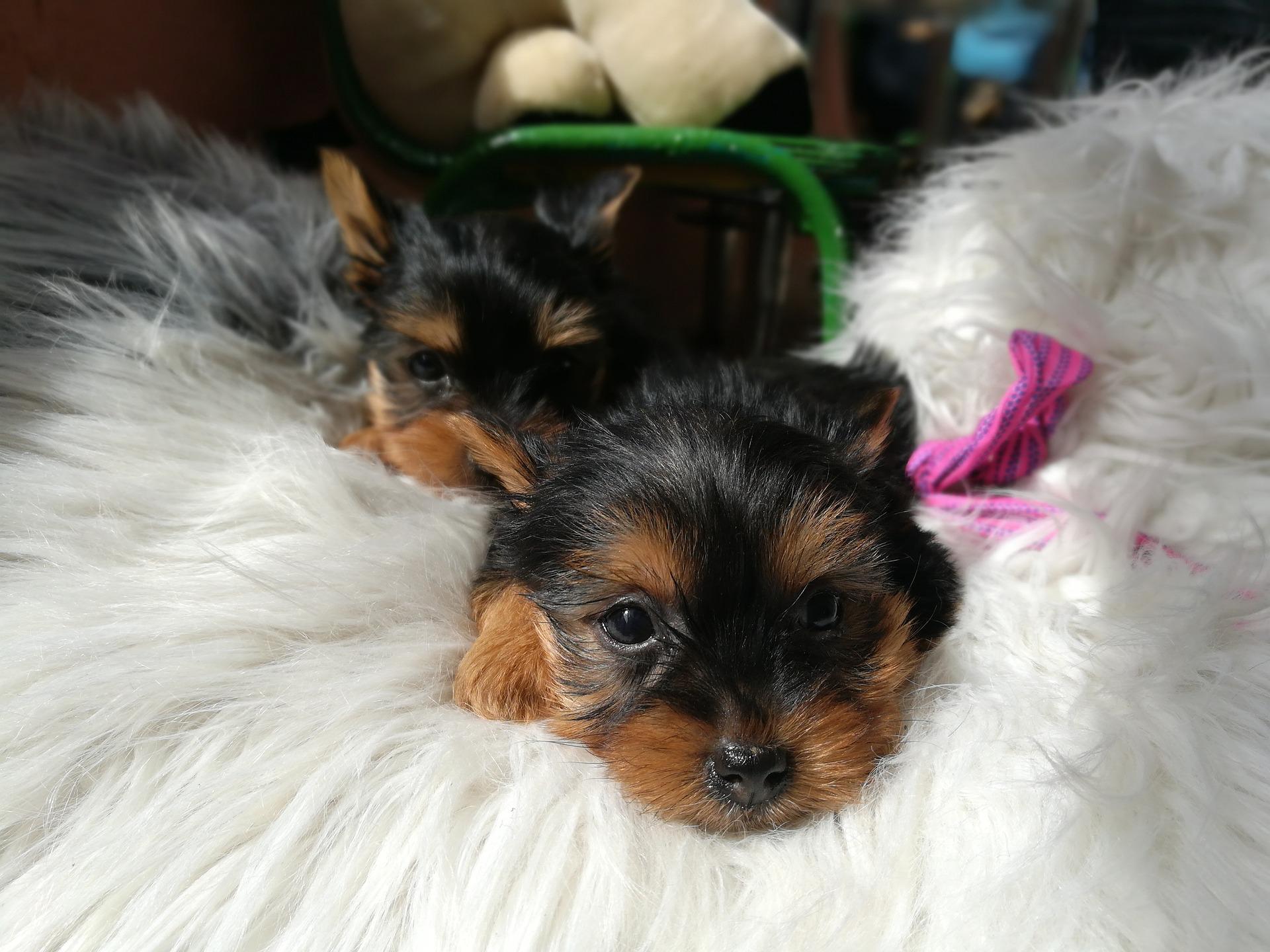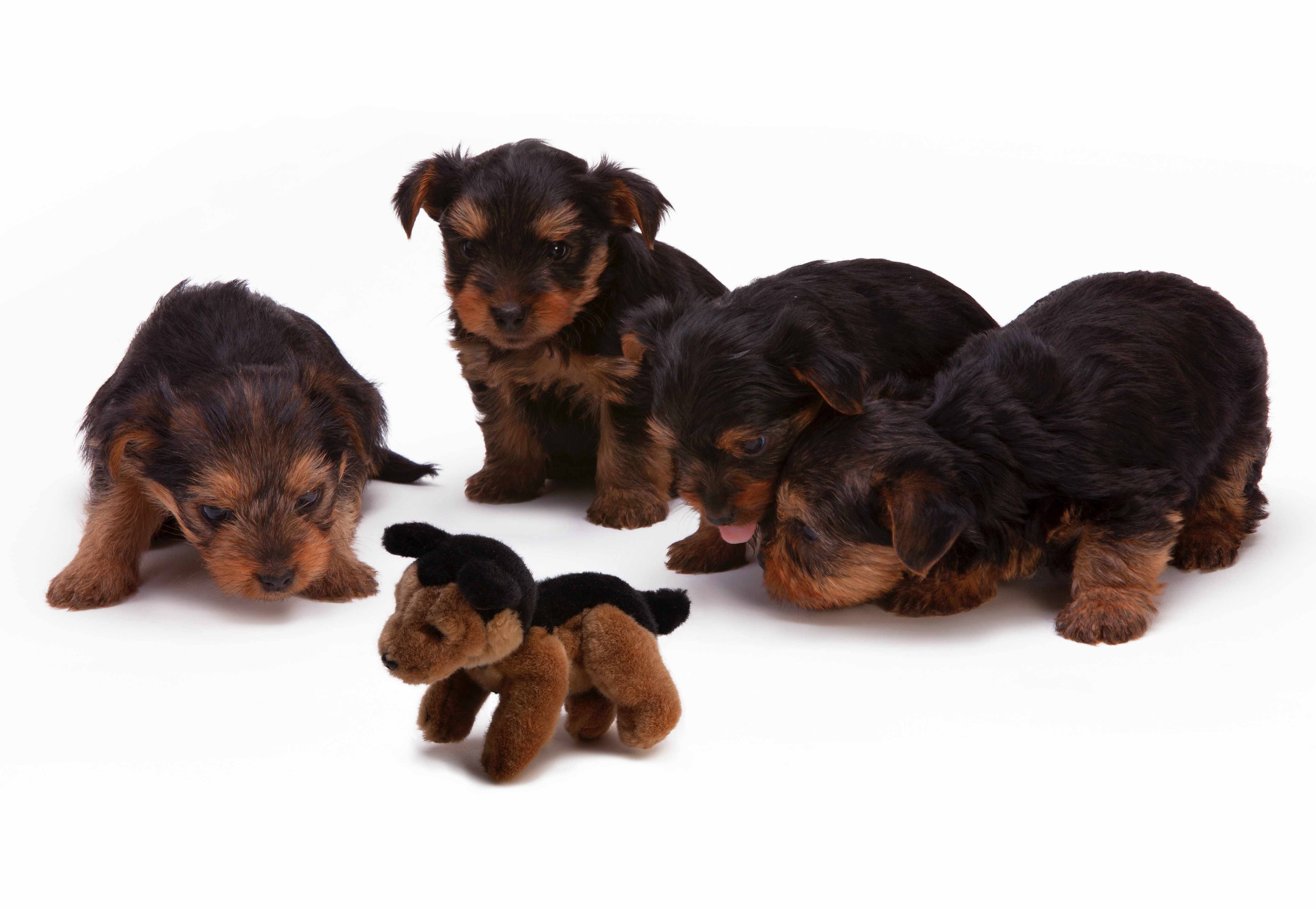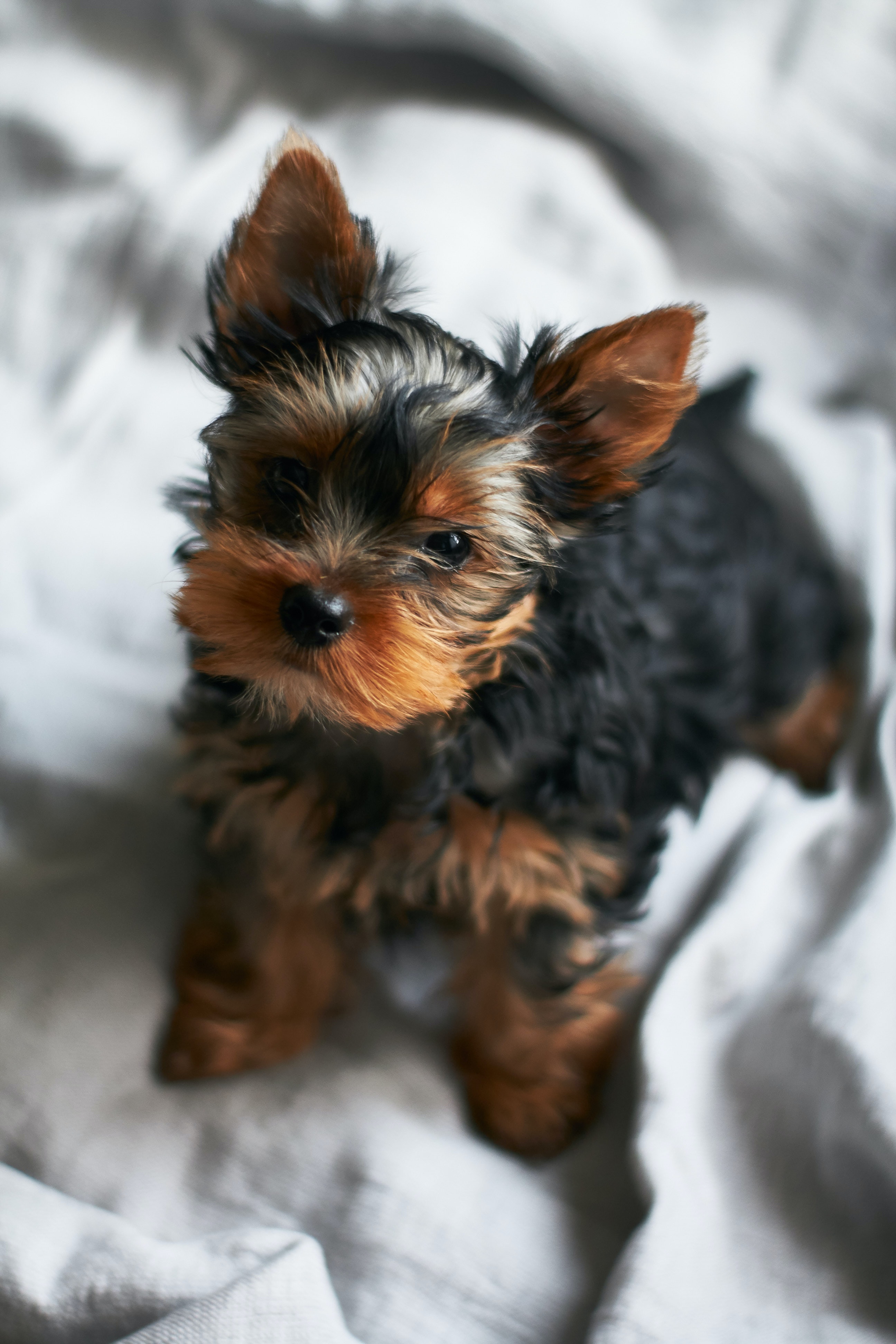
Puppy Nursery
|
Puppies are grown in our house with our family. Even when the weather
is bad, we have designated portions of our house for puppy play areas
where they may run, play, and develop their young minds and bodies.
They're also mixed up with the many noises, scents, and activities of a
busy family with small children. Each week has certain goals that have
been established through time and study. Our puppy areas are cleansed
and disinfected twice a day. We attempt to create a bright, clean,
appealing, caring, and pleasant environment for the pups and their
mothers. It is our responsibility to teach puppies that humans
equal love and that there are proper ways to investigate, react to, and
interact with the world around them.
The first eight weeks of a puppy's existence are crucial for forming
reactions to the world around them. Because of what we do when the pups
are here in our house during their initial weeks of life, we've
received a lot of favorable comments about how readily our puppies
adapt to training and adjust to their new homes. The Puppy Culture Method
is something we use and embrace because we believe it results in happy,
well-adjusted pups and happy pet owners! We also employ the Bad Ass BreederEarly Neurological
Stimulation (ENS), Early Scent
Introduction and Temperament Testing.
We also use the Rule of Sevens, and
the Misty Method, as well as our own tweaks,
techniques, and processes
that we've acquired through many years of growing this breed. |
This comprises the
fundamentals.
ENS/ESI
Early Neurological Stimulation (ENS) is a set of handling exercises
that has been shown to modify the brain's reaction to new stimuli.
Developed by the United States military to promote trainability, brain
function, and the production of tolerant and relaxed pets. Early Scent
Induction: Each day, provide a fresh scent to excite the brain. The
ENS/ESI procedure is carried out on days 3 through 16 of life. We
progress to puppy massages as they grow older, where we get them
comfortable to having their jaws, paws, and ears rubbed.
|
Behavioral
Training
We start toilet training and teaching on etiquette like as sitting or
"manding" while a human is around by week three. Baths, nail clipping,
and blowdries are given to puppies once a week to get them acquainted
to the process. We focus on bite inhibition, resource guarding, and
crate training as they become older.
|
New
Experiments
Puppies are introduced to properly trying situations as they get older,
such as learning to climb out of their whelping enclosure on their own
or figuring out how to get to their feeding dish when a little obstacle
stands in their way. Small slides, stairwells, and a variety of
materials to walk on are all available. These activities are intended
to teach puppies how to solve problems and remain calm in unfamiliar
situations. It strengthens their bodies and minds.
|
Socialization
Puppies spend time with "nanny dogs" who help train them and socialize
with people of all ages. Every day, we give them new experiences, such
as vacuum cleaners, music, water, vehicle trips, new sounds, new pet
pen configurations, ball pits, stairs, new toys, slides, people wearing
hats and masks, and so on.
|
Training pups from the beginning takes a lot of time and effort, but
it's well worth it when you see the training click with each youngster.
To put things in perspective, a litter of eight pups is a lot to offer
specialized care to, much alone daily individualized attention,
training, and conditioning for eight weeks, but it's the time spent on
these puppies that makes the difference. The half-hour it takes every
night to educate pups to take goodies so you can successfully praise
them later. The three hours it takes them every night to comb through
the entire litter in search of their first box game. The 15 minutes it
takes to convince each puppy that you taking their cherished object is
the finest thing that could ever happen to them is well worth
it. These are the activities that provide pups the tools to
seek enrichment and confidently engage with their surroundings. It is
for this reason that they are bold.
|
Days 0-14
In their whelping box, the puppies are
kept warm and may feed virtually continuously. They are constantly
observed at all times of the day. We give customized bedding that helps
our puppies to crawl on their stomachs with traction. As research is
establishing the link between hip dysplasia and environmental variables
like whelping box material, correct traction in the whelping box is
critical for optimal hip and knee development. We weigh our puppies
twice a day to make sure they're getting enough milk and developing
correctly. At 3 days old, we start ENS (Early Neurological Stimulation)
& ESI (Early Scent Introduction) with the puppies.Please visit our
Pages to learn more about them Early
Neurological Stimulation & Early
Scent Introduction |
Days
14-21
Puppies' eyes open at 14 days of age,
and they start "toddling" around. We begin taking them on automobile
drives to desensitize them to the motion of being in a vehicle. This
ensures that the pups do not have accidents when they return home with
you. We feed meals to them at week three and include a toilet tray with
their bedding. This is due to the fact that they automatically begin to
leave their nursing bed in order to eliminate. If a breeder fails to
notice these indicators, she may be able to influence this natural
inclination by failing to provide a "separate" bathroom space. Within a
week, the litter pan will be used more frequently than the bedding. We
finish the ENS & ESI training and continue to love and hold our
babies. |
Week
3
This is a fantastic age to be alive!
You would not believe there's much that can be done with such a young
puppy, but you'd be wrong. Puppy pups have practically little fear at
three weeks old, according to research. They do have a high startle
reaction, though. As a result, this is a great time to start teaching
"Startle Recovery." Anything that will scare the pups, such as dropping
metal dog-food plates, slamming about, vacuuming, sneezing, coughing,
or dumping a stack of books. We play Canine Audio Therapy sounds over a
speaker. We also cut puppy nails to help them get used to having their
feet handled. Finally, we will ensure that each puppy is removed one at
a time and that we spend specific time with each one. This aids
in the development of a healthy human link as well as the reduction of
separation anxiety later in life. |
Week
4
 Puppies
are already carrying toys and loving chasing each other and getting
plenty of exercise. Physical activity in early puppies has been shown
to assist their brains expand the ability to learn and bond, according
to studies. As a result, we expand their dwelling area at this period.
We continue to expose them to new barriers and sounds while also
creating difficulties for them to overcome. We created problem-solving
scenarios for them, such as a basic barrier between them and their food
that they had to learn to navigate around in order to get food. At this
age, problem solving and learning are critical, and we have a lot of
fun coming up with new methods to accomplish it! At this age, we also
begin "Clicker Training," which is a fantastic tool for the puppy that
it can use it's entire life. Puppies
are already carrying toys and loving chasing each other and getting
plenty of exercise. Physical activity in early puppies has been shown
to assist their brains expand the ability to learn and bond, according
to studies. As a result, we expand their dwelling area at this period.
We continue to expose them to new barriers and sounds while also
creating difficulties for them to overcome. We created problem-solving
scenarios for them, such as a basic barrier between them and their food
that they had to learn to navigate around in order to get food. At this
age, problem solving and learning are critical, and we have a lot of
fun coming up with new methods to accomplish it! At this age, we also
begin "Clicker Training," which is a fantastic tool for the puppy that
it can use it's entire life.
|
Week 5
We've had the luxury of encouraging a startle recovery
response in the puppies without having to worry about actual fear up
until now. However, as the puppies near 5 weeks of age, the game
shifts. We employ extra caution when exposing the puppies now that they
are developing actual fear responses. A single occurrence can have a
long-term impact on children at this age, when they are in the "fear
imprint period." We're keeping a careful eye on individual reactions at
this critical period to see if we need to assist a puppy overcome a
phobia of a specific sound, item, scent, or texture. We're also working
on clicker training, "manding" (as described in "Puppy Culture"),
overcoming barriers, interacting with people and animals, and toilet
training. |
Week
6
At this age, puppies are incredibly
curious. They're approaching a peak period for socializing and
continuing to have good times. This is an excellent age to begin
introducing them to as many people as possible. We also introduce them
to more unstable things, such as small agility equipment, to help them
gain confidence. We'll definitely start playing in the outdoor puppy
yard about week 6 if they haven't already. Puppies are taken to
the vet, vaccinated and given health evaluations. |
Week 7
Our puppies have a good handle on potty training at this
age, generally only using the potty pads to eliminate. They're highly
lively, and their capacity to "mand" (as discussed in the Puppy Culture
films), overcome shock, learn, and even love demonstrates our hard work
with them. Baths and nail trims are second nature to them, as is
brushing. |
Week
8
. We continue to work with the puppies. Socialization is
continued. Puppies are
Temperament Tested during this time. The
examination tells us how the dog's structure compares to that of the
"standard" breed. Evaluator examines the dog's anatomy, especially the
head, as well as its disposition. This is a crucial day for the litter
since we will determine whether or not to keep a puppy for
breeding. Periods of
fear begin. Fear periods are a natural part
of puppy growth; never theless,
understanding how to cope with them, what to do, and most importantly,
what not to do, has long-term consequences for the adult dog and his
family. With our knowledge, we can
both notice when a puppy is going through a fear stage and assist them
get through it without causing any stress that may impact their
disposition in the long run.Periods of fear begin. Fear periods are a
natural part of puppy growth; nevertheless, understanding how to cope
with them, what to do, and most importantly, what not to do, has
long-term consequences for the adult dog and his family. With our
knowledge, we can both notice when a puppy is going through a fear
stage and assist them get through it without causing any stress that
may impact their disposition in the long run. Puppies are taken
to the vet again, vaccinated, microchipped and given another health
evaluation. theless,
understanding how to cope with them, what to do, and most importantly,
what not to do, has long-term consequences for the adult dog and his
family. With our knowledge, we can
both notice when a puppy is going through a fear stage and assist them
get through it without causing any stress that may impact their
disposition in the long run.Periods of fear begin. Fear periods are a
natural part of puppy growth; nevertheless, understanding how to cope
with them, what to do, and most importantly, what not to do, has
long-term consequences for the adult dog and his family. With our
knowledge, we can both notice when a puppy is going through a fear
stage and assist them get through it without causing any stress that
may impact their disposition in the long run. Puppies are taken
to the vet again, vaccinated, microchipped and given another health
evaluation. |
Week 9
We continue our work with the puppies.. Puppies'
weaning pens are being extended to give them more area to exercise and
avoid fighting, while new enrichment items and toys are being provided
on a regular basis. Kibble Nibbles, Wobblers, Squirrel Dudes, and plush
Kongs are among the new kibble dispensers. Puppies and dogs who labor
for their food are calmer, have fewer behavioral issues, and learn to
tolerate frustration. Puppies
receive their first puppy groom by a professional groomer, faces, feet
and fanny's are clipped. |
Week
10
Our hard work comes to an end, and
the torch is handed on to our new family, who are both nervous and eager
|
|

 Puppies
are already carrying toys and loving chasing each other and getting
plenty of exercise. Physical activity in early puppies has been shown
to assist their brains expand the ability to learn and bond, according
to studies. As a result, we expand their dwelling area at this period.
We continue to expose them to new barriers and sounds while also
creating difficulties for them to overcome. We created problem-solving
scenarios for them, such as a basic barrier between them and their food
that they had to learn to navigate around in order to get food. At this
age, problem solving and learning are critical, and we have a lot of
fun coming up with new methods to accomplish it! At this age, we also
begin "Clicker Training," which is a fantastic tool for the puppy that
it can use it's entire life.
Puppies
are already carrying toys and loving chasing each other and getting
plenty of exercise. Physical activity in early puppies has been shown
to assist their brains expand the ability to learn and bond, according
to studies. As a result, we expand their dwelling area at this period.
We continue to expose them to new barriers and sounds while also
creating difficulties for them to overcome. We created problem-solving
scenarios for them, such as a basic barrier between them and their food
that they had to learn to navigate around in order to get food. At this
age, problem solving and learning are critical, and we have a lot of
fun coming up with new methods to accomplish it! At this age, we also
begin "Clicker Training," which is a fantastic tool for the puppy that
it can use it's entire life. theless,
understanding how to cope with them, what to do, and most importantly,
what not to do, has long-term consequences for the adult dog and his
family. With our knowledge, we can
both notice when a puppy is going through a fear stage and assist them
get through it without causing any stress that may impact their
disposition in the long run.Periods of fear begin. Fear periods are a
natural part of puppy growth; nevertheless, understanding how to cope
with them, what to do, and most importantly, what not to do, has
long-term consequences for the adult dog and his family. With our
knowledge, we can both notice when a puppy is going through a fear
stage and assist them get through it without causing any stress that
may impact their disposition in the long run. Puppies are taken
to the vet again, vaccinated, microchipped and given another health
evaluation.
theless,
understanding how to cope with them, what to do, and most importantly,
what not to do, has long-term consequences for the adult dog and his
family. With our knowledge, we can
both notice when a puppy is going through a fear stage and assist them
get through it without causing any stress that may impact their
disposition in the long run.Periods of fear begin. Fear periods are a
natural part of puppy growth; nevertheless, understanding how to cope
with them, what to do, and most importantly, what not to do, has
long-term consequences for the adult dog and his family. With our
knowledge, we can both notice when a puppy is going through a fear
stage and assist them get through it without causing any stress that
may impact their disposition in the long run. Puppies are taken
to the vet again, vaccinated, microchipped and given another health
evaluation. 



